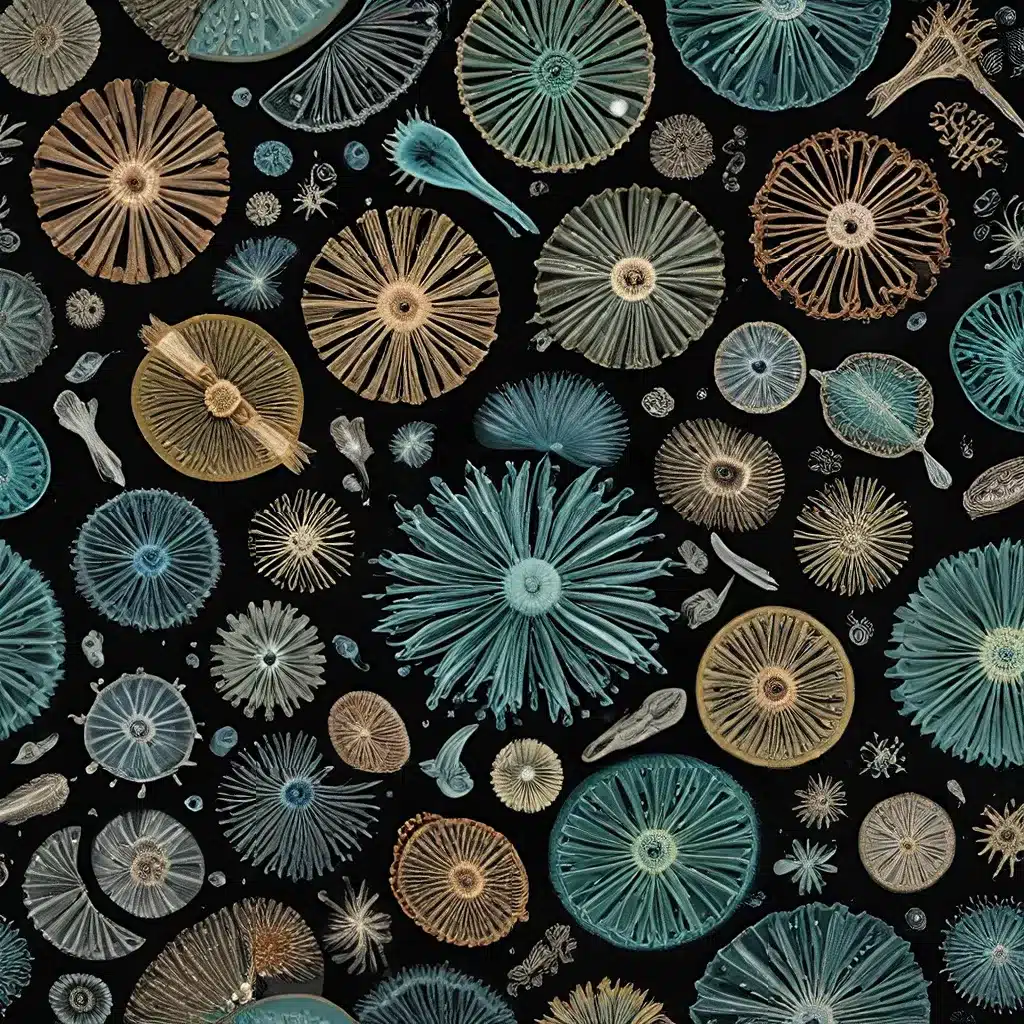
Unlocking the Secrets of Diatoms: Nature’s Intricate Art
Diatoms are truly remarkable organisms. These tiny, single-celled creatures inhabit a wide range of aquatic environments, from vast oceans to serene freshwater lakes. While their diminutive size may lead some to overlook them, diatoms are far from insignificant. In fact, these microscopic marvels play a crucial role in the delicate balance of our planet’s ecosystems.
Not only do diatoms produce a significant portion of the world’s oxygen, but they also serve as a vital food source for countless aquatic species. Their intricate, glass-like shells, known as frustules, are a sight to behold – a true testament to the extraordinary diversity and artistry found in nature. These frustules come in a dazzling array of shapes, sizes, and colors, each one a unique and captivating work of art.
Diatoms are often referred to as “nature’s architects” due to their incredible ability to create intricate, symmetrical designs. These patterns are not merely aesthetic – they serve a vital purpose, helping diatoms to absorb nutrients, avoid predators, and move through the water with ease. But even with their functional design, the beauty of diatoms is undeniable, inspiring artists and designers alike to incorporate their mesmerizing patterns into a wide range of media.
Exploring the Diverse World of Diatoms
Diatoms come in a vast array of shapes and sizes, each species uniquely adapted to its aquatic environment. Some diatoms have a circular or oval shape, while others are more elongated or even triangular. What truly sets them apart, however, is the incredible variety of patterns and designs adorning their silica-based frustules.
Some diatoms feature radial lines, while others boast zig-zags or spirals. Some have tiny pores or holes scattered across their shells, while others display intricate lattice-like patterns. The diversity of diatom designs is truly astounding, and their colors are equally captivating.
Diatoms can range from bright green to deep vibrant red, with shades of yellow, gold, and blue also represented. The color of a diatom’s shell is often directly related to its environment, with warmer, more tropical waters typically producing more vibrant hues, while colder, polar regions tend to host more subdued species.
Diatoms as Indicators of Water Quality
Diatoms are not just beautiful – they are also incredibly important in the assessment of aquatic environments. These microscopic organisms serve as valuable bioindicators, providing insights into the overall health and quality of a given water body. By analyzing the composition and abundance of diatom species, scientists and aquarium enthusiasts can gain valuable information about the underlying water chemistry, nutrient levels, and even the long-term trends in a particular ecosystem.
Martyn Kelly, an expert in freshwater ecosystems and diatom research, has extensively documented how the presence and distribution of different diatom species can indicate changes in water quality over time. For instance, certain diatom species thrive in nutrient-rich waters, while others prefer more oligotrophic (low-nutrient) conditions. By monitoring the shifts in diatom populations, aquarists can better understand the overall health of their aquarium and make informed decisions about water management and maintenance.
Leveraging Diatoms for Sustainable Aquascaping
The intricate beauty and functional design of diatoms have captured the imagination of aquarium enthusiasts and aquascapers alike. These microscopic organisms have become a source of inspiration for creating truly stunning and naturalistic aquarium landscapes. By incorporating diatom-inspired elements into their aquascapes, hobbyists can achieve a level of realism and visual depth that truly immerses the viewer in the aquatic world.
One innovative approach is the use of diatom-based sculptures or structures within the aquarium, such as the cast-iron diatom sculptures created by artist Andrew McKeown and installed in a park in Durham, UK. These tangible representations of diatoms allow aquarists to bring the beauty of these microscopic creatures into the physical realm, providing a unique and engaging way for both children and adults to interact with and appreciate the diversity of the aquatic world.
Harnessing Diatoms for the Future of Aquarium Keeping
As our understanding of diatoms continues to grow, their potential applications in the aquarium hobby are also expanding. One particularly exciting development is the consideration of diatoms as a viable source of biofuel. Researchers have found that diatoms, with their high proportion of monounsaturated fatty acids, could be an excellent starting material for the production of sustainable biofuels. This discovery could have significant implications for the future of aquarium keeping, as it opens up the possibility of utilizing diatoms as a clean and renewable energy source for powering aquarium equipment and lighting.
Moreover, the unique properties of diatom shells, such as their abrasiveness and ability to act as effective filtering agents, have led to their use in a variety of industrial applications, including as polishing agents and natural insecticides. These diverse applications underscore the immense potential of diatoms and highlight the importance of continued research and exploration in this fascinating field.
As you delve deeper into the captivating world of diatoms, King Aquarium encourages you to consider how these microscopic marvels can enhance your own aquarium journey. Whether you’re seeking to create a visually stunning aquascape, optimize your water quality, or explore the potential of diatoms as a sustainable resource, the fascinating insights and practical advice presented in this article will surely inspire you to unlock the full potential of these dazzling, microscopic wonders.

